1998 PONTIAC GRAND PRIX lock
[x] Cancel search: lockPage 92 of 402

LOCK (B): Before you put the key into the ignition
switch, the switch is in LOCK. It’s
also the only position
from which you can remove your key.
This position
locks your ignition, steering wheel and transaxle. It’s a
theft-deterrent feature.
OFF (C): This position lets you turn off the engine but
still turn the steering wheel. It doesn’t lock the steering
wheel like
LOCK. Use OFF if you must have your
vehicle pushed or towed.
RUN (D): This position is where the key returns
after you start your vehicle. With the engine
off, you
can use RUN to display some of your warning and
indicator lights.
START (E): This position starts your engine.
A warning chime will sound if you open the driver’s
door when the ignition is in
OFF, LOCK or
ACCESSORY and the key is in the ignition.
NOTICE:
If your key seem stuck in LOCK and you can’t
turn it, be sure you are using the correct key;
if
so, is it all the way in? If it is, then turn the
steering wheel left and right while
you turn the
key hard. But turn the key only with your hand.
Using a tool to force it could break the key
or the
ignition switch.
If none of this works, then your
vehicle needs service.
Retained Accessory Power
With retained accessory power, your power windows, audio system and sunroof will continue to work up to
10 minutes after the ignition key is turned to OFF and
none of the doors are opened.
Starting Your Engine
Move your shift lever to PARK (P) or NEUTRAL (N).
Your engine won’t start in any other position -- that’s a
safety feature.
To restart when you’re already moving,
use
NEUTRAL (N) only.
2-17
~~
Page 96 of 402

How long should you keep the coolant heater plugged
in? The answer depends on the outside temperature, the
kind of oil you have, and some other things. Instead of
trying to list everything here, we ask that you contact
your dealer in the area where you’ll be parking your
vehicle. The dealer can give you the best advice for that
particular area.
Automatic Transaxle Operation
I ‘%
6
10
Your automatic transaxle may have a shift lever on the
steering column or on the console between the seats.
Maximum engine speed is limited when you’re in
PARK (P) or NEUTRAL (N), to protect driveline
components from improper operation. There are several different positions
for your shift lever.
PARK
(P): This locks your front wheels. It’s the best
position to use when you start your engine because your
vehicle can’t move easily.
It is dangerous to get out of your vehicle if the
shift lever
is not fully in PARK (P) with the
parking brake firmly set. Your vehicle can roll.
Don’t leave your vehicle when the engine
is
running unless you have to. If you have left the
engine running, the vehicle can move suddenly.
You or others could be injured. To be sure your
vehicle won’t move, even when you’re on fairly
level ground, always set your parking brake and
move the shift lever to PARK
(P).
See “Shifting Into PARK (P)” in the Index. If
you’re pulling a trailer, see “Towing a Trailer” in
the Index.
2-21
Page 97 of 402
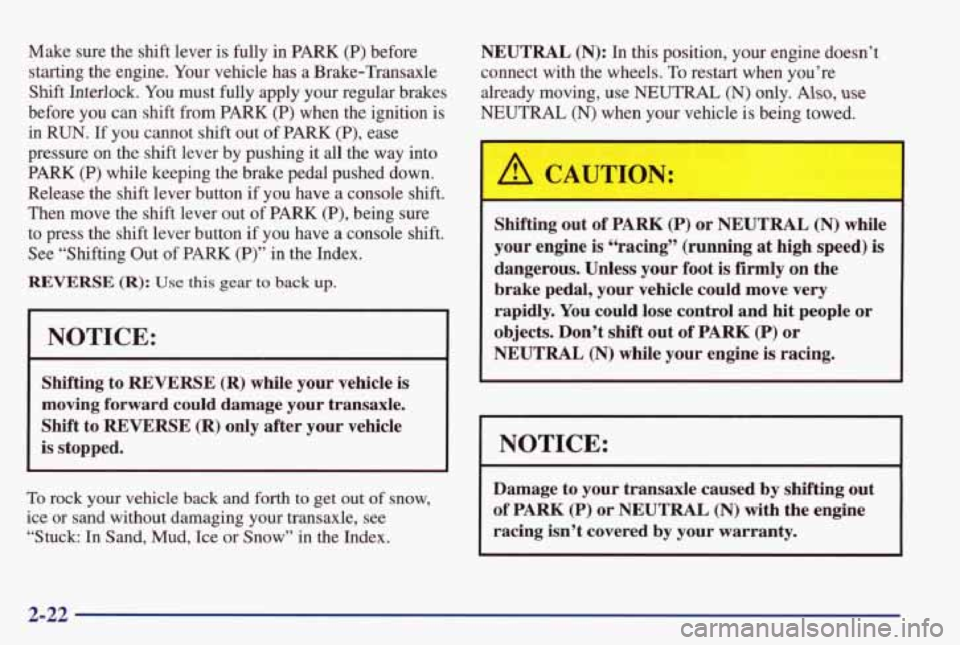
Make sure the shift lever is fully in PARK (P) before
starting the engine. Your vehicle has a Brake-Transaxle
Shift Interlock. You must fully apply your regular brakes
before
you can shift from PARK (P) when the ignition is
in RUN. If you cannot shift out
of PARK (P), ease
pressure on the shift lever by pushing it all the way into
PARK
(P) while keeping the brake pedal pushed down.
Release the shift lever button
if you have a console shift.
Then move the shift lever out
of PARK (P), being sure
to press the shift lever button
if you have a console shift.
See “Shifting Out of PARK
(P)” in the Index.
REVERSE (R): Use this gear to back up.
NOTICE:
Shifting to REVERSE (R) while your vehicle is
moving forward could damage your transaxle.
Shift to REVERSE (R) only after your vehicle
is stopped.
To rock your vehicle back and forth to get out of snow,
ice or sand without damaging your transaxle, see
“Stuck: In Sand, Mud, Ice or Snow” in the Index. NEUTRAL
(N): In
this position, your engine doesn’t
connect with the wheels. To restart when you’re
already moving, use NEUTRAL
(N) only. Also, use
NEUTRAL (N) when your vehicle is being towed.
I
I
A CAUTION: I
Shifting out of PARK (P) or NEUTRAL (N) while
your engine is “racing” (running at high speed) is
dangerous. Unless your
foot is firmly on the
brake pedal, your vehicle could move very
rapidly. You could lose control and hit people or
objects. Don’t shift out of PARK
(P) or
NEUTRAL
(N) while your engine is racing.
NOTICE:
Damage to your transaxle caused by shifting out
of PARK (P) or NEUTRAL (N) with the engine
racing isn’t covered by your warranty.
2-22
Page 100 of 402
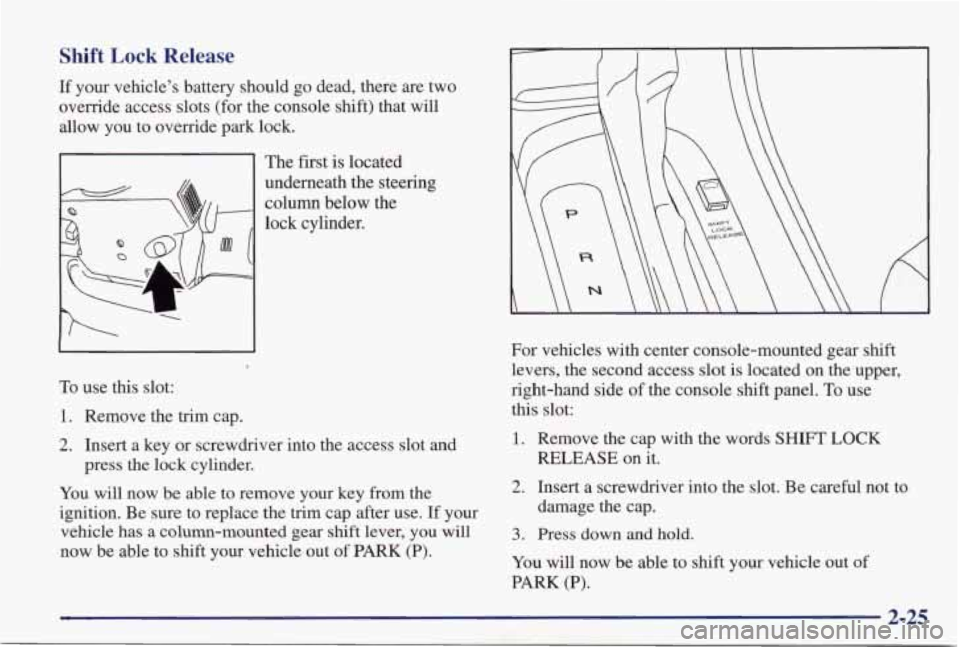
Shift Lock Release
If your vehicle’s battery should go dead, there are two
override access slots (for the console
shift) that will
allow you to override park lock.
11 The first is located
underneath the steering
column below the
lock cylinder.
1
To use this slot:
1. Remove the trim cap.
2. Insert a key or screwdriver into the access slot and
You will now be able to remove your key from the
ignition. Be sure to replace the
trim cap after use. If your
vehicle
has a column-mounted gear shift lever, you will
now be able to shift your vehicle out of
PARK (P).
press the lock cylinder. For vehicles with center console-mounted gear shift
levers, the second access slot is located on the upper,
right-hand side of the console shift panel.
To use
this slot:
1. Remove the cap with the words SHIFT LOCK
RELEASE on it.
2. Insert a screwdriver into the slot. Be careful not to
damage the cap.
3. Press down and hold.
You will now be able to shift your vehicle out of
PARK (P) .
2-25
Page 103 of 402
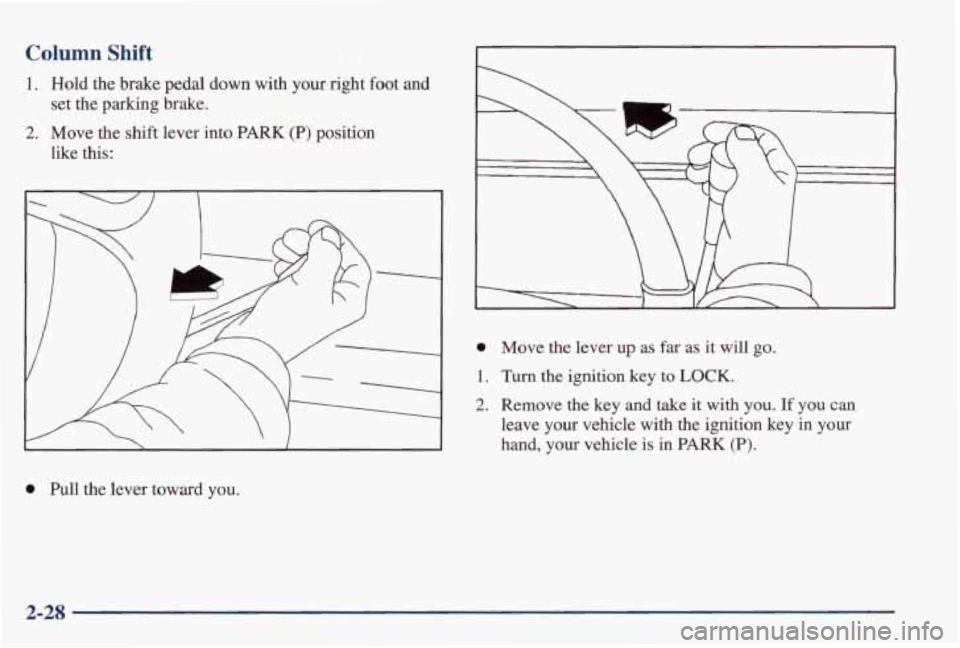
Column Shift
1. Hold the brake pedal down with your right foot and
2. Move the shift lever into PARK (P) position
set the parking brake.
like this:
0 Move the lever up as far as it will go.
1. Turn the ignition key to LOCK.
2. Remove the key and take
it with you. If you can
leave your vehicle with the ignition key in your
hand, your vehicle is in
PARK (P).
0 Pull the lever toward you.
2-28
Page 104 of 402
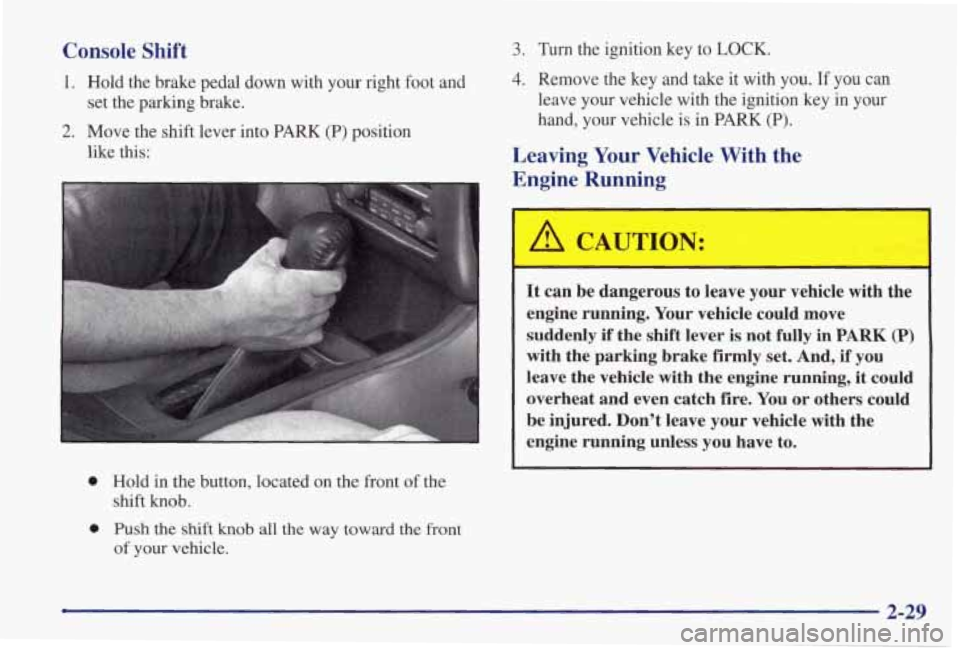
Console Shift
1. Hold the brake pedal down with your right foot and
2. Move the shift lever into PARK (P) position
set
the parking brake.
like this:
0 Hold in the button, located on the front of the
0 Push the shift knob all the way toward the front
shift
knob.
of your vehicle.
3. Turn the ignition key to LOCK.
4. Remove the key and take
it with you. If you can
leave
your vehicle with the ignition key in your
hand,
your vehicle is in PARK (P).
Leaving Your Vehicle With the
Engine Running
I
r
1
A CAUTION:
It can be dangerous to leave your vehicle with the
engine running. Your vehicle could move
suddenly if the shift lever is not fully
in PARK (P)
with the parking brake firmly set. And, if you
leave the vehicle with the engine running, it could
overheat and even catch fire. You or others could
be injured. Don’t leave your vehicle with the
engine running unless you have to.
2-29
Page 105 of 402

If you have to leave your vehicle with the engine running,
be sure your vehicle is in
PARK (P) and your parking
brake is
firmy set before you leave it. After you’ve moved
the
shift lever into PARK (P) position, hold the regular
brake
pedal down. Then, see if you can move the shift
lever away from PARK (P) without first pulling it toward
you (or,
if you have a console shift lever, without first
pushing the button).
If you can, it means that the shift
lever wasn’t fully locked into PARK (P).
Torque Lock
If you are parking on a hill and you don’t shift your
transaxle into
PARK (P) properly, the weight of the
vehicle may put too much force on the parking pawl
in
the transaxle. You may find it difficult to pull the shift
lever out of
PARK (P). This is called “torque lock.” To
prevent torque lock, set the parking brake and then shift
into
PARK (P) properly before you leave the driver’s
seat.
To find out how, see “Shifting Into PARK (P)” in
the Index.
When you are ready to drive, move the shift lever out
of
PARK (P) before you release the parking brake.
If torque lock does occur, you may need to have another
vehicle push yours a little uphill to take some of the
pressure from the parking pawl in the transaxle,
so you
can pull the shift lever out
of PARK (P).
Shifting Out of PARK (P)
Your vehicle has a Brake-Transaxle Shift Interlock. You
must fully apply your regular brakes before you can
shift from PARK (P) when the ignition is in RUN. See
“Automatic Transaxle Operation” in the Index.
If you cannot shift out
of PARK (P), ease pressure on
the shift lever by pushing it all the way into PARK (P)
while keeping the brake pedal pushed down. Release the
shift lever button if you have a console shift. Then move
the shift lever out of
PARK (P), being sure to press the
shift lever button if you have a console shift.
If you ever hold the brake pedal down but still can’t
shift out of
PARK (P) with column shift, try this:
1. Turn the key to OFF.
2. Apply and hold the brake until the end of Step 4.
3. Shift to NEUTRAL (N).
4. Start the engine and shift to the drive gear you want.
5. Have the vehicle fixed as soon as you can.
With the console shift lever, see “Shift Lock Release”
earlier
in this section.
2-30
Page 108 of 402
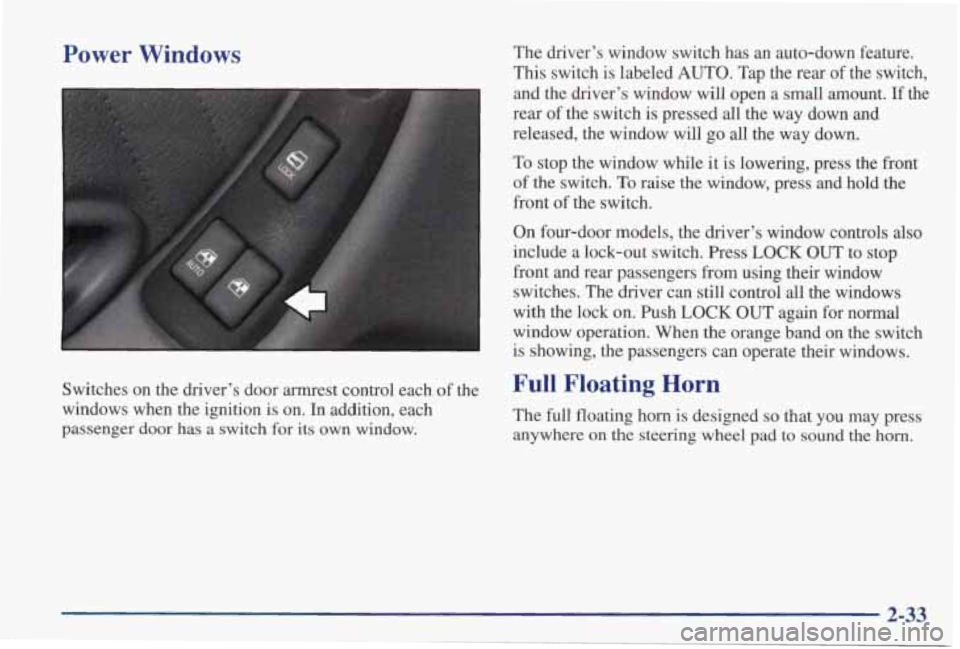
Power Windows
Switches on the driver’s door armrest control each of the
windows when the ignition
is on. In addition, each
passenger door has a switch
for its own window. The
driver’s window switch has an auto-down feature.
This switch is labeled AUTO. Tap the rear of the switch,
and the driver’s window will open a small amount.
If the
rear of the switch is pressed
all the way down and
released, the window will go
all the way down.
To stop the window while it is lowering, press the front
of the switch.
To raise the window, press and hold the
front of the switch.
On four-door models, the driver’s window controls also
include a lock-out switch. Press LOCK OUT to stop
front and rear passengers from using their window
switches. The driver can still control
all the windows
with the lock on. Push
LOCK OUT again for normal
window operation. When the orange band
on the switch
is showing, the passengers can operate their windows.
Full Floating Horn
The full floating horn is designed so that you may press
anywhere
on the steering wheel pad to sound the horn.
2-33